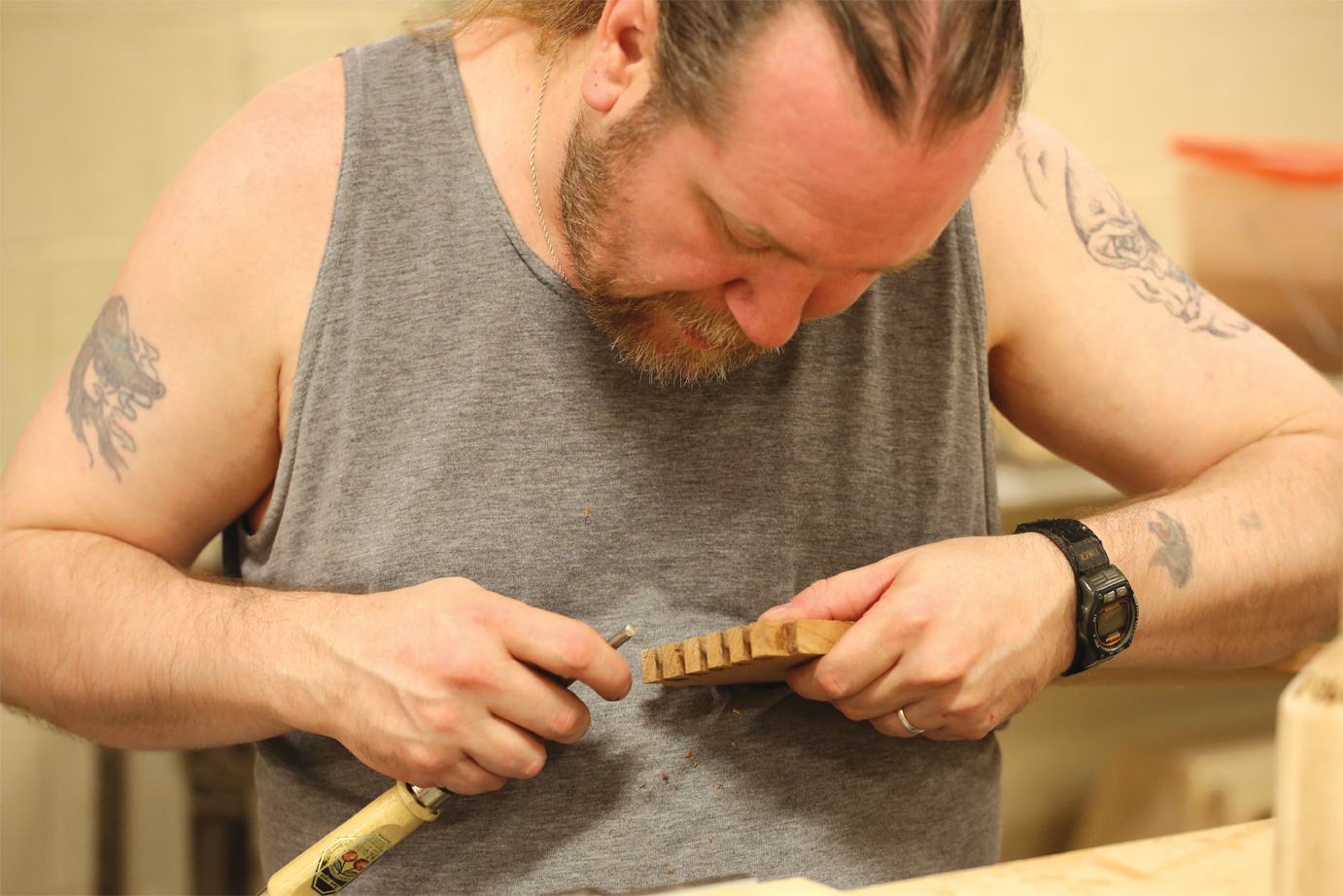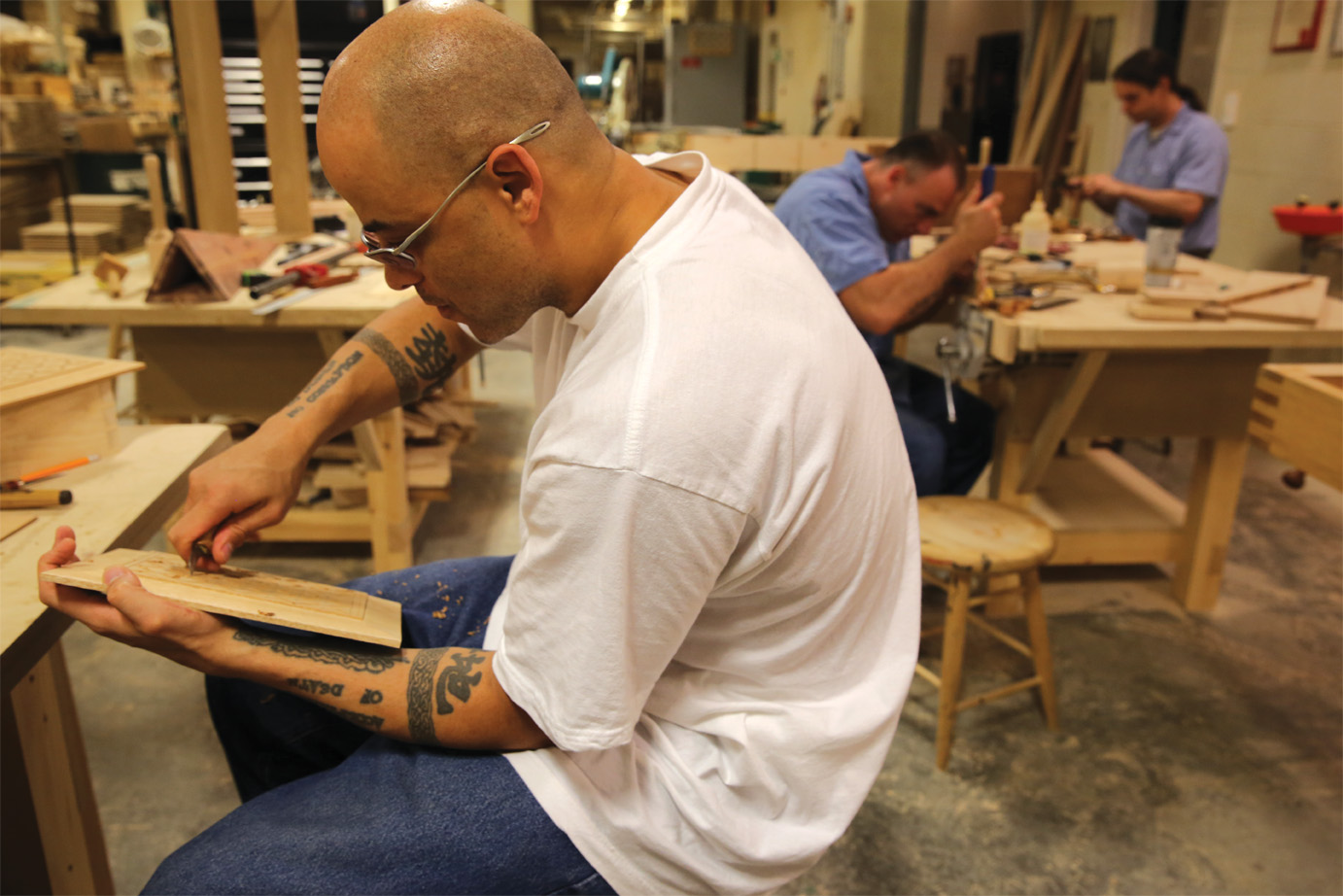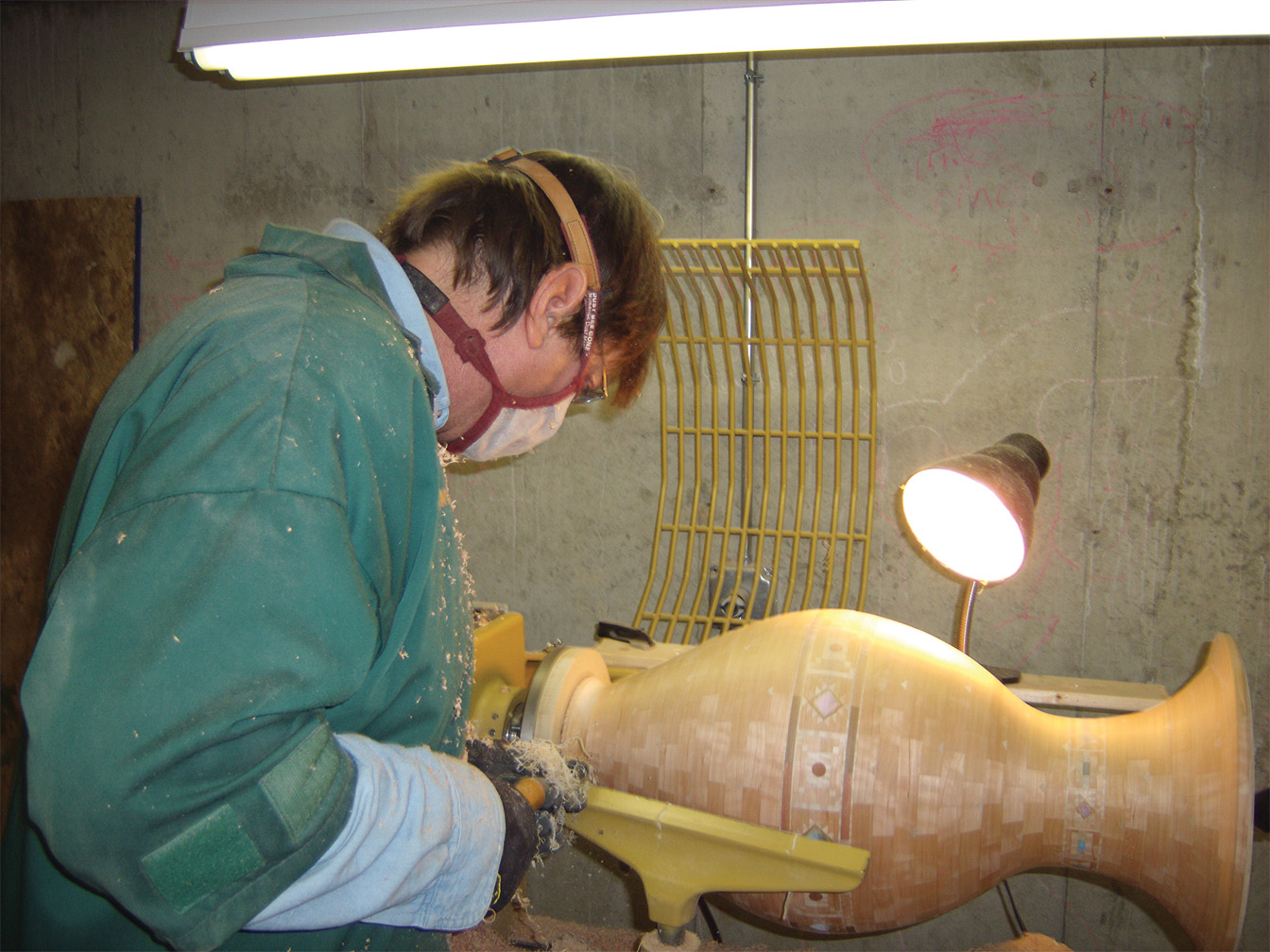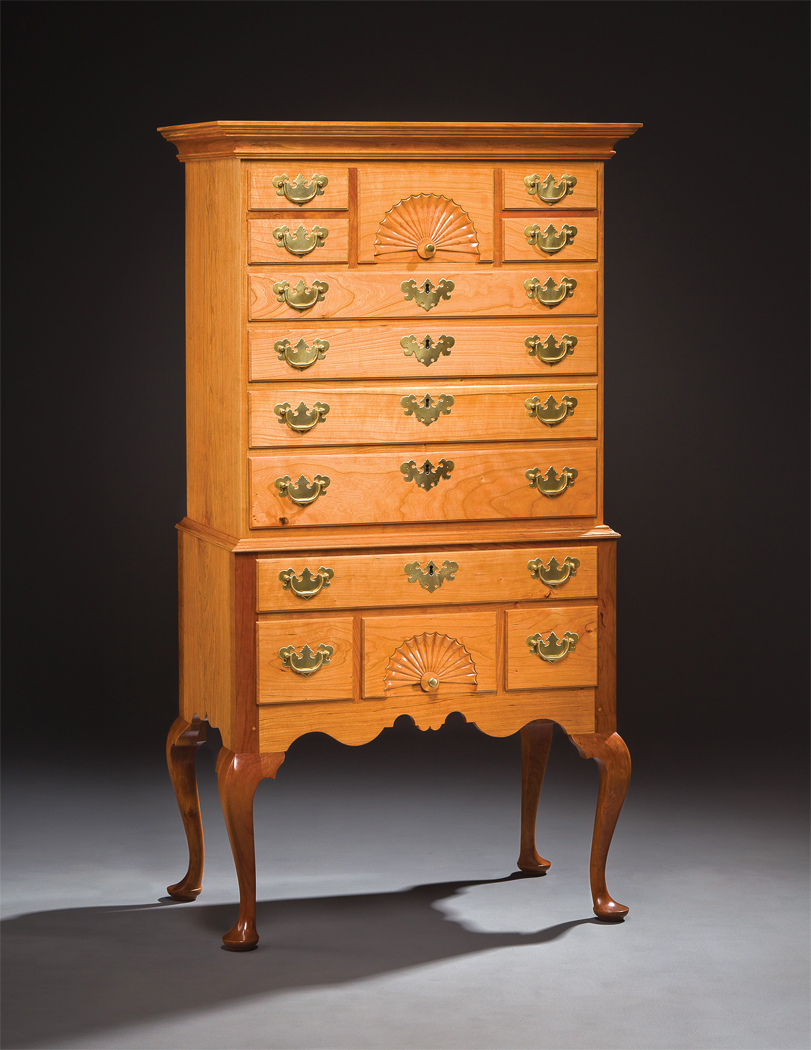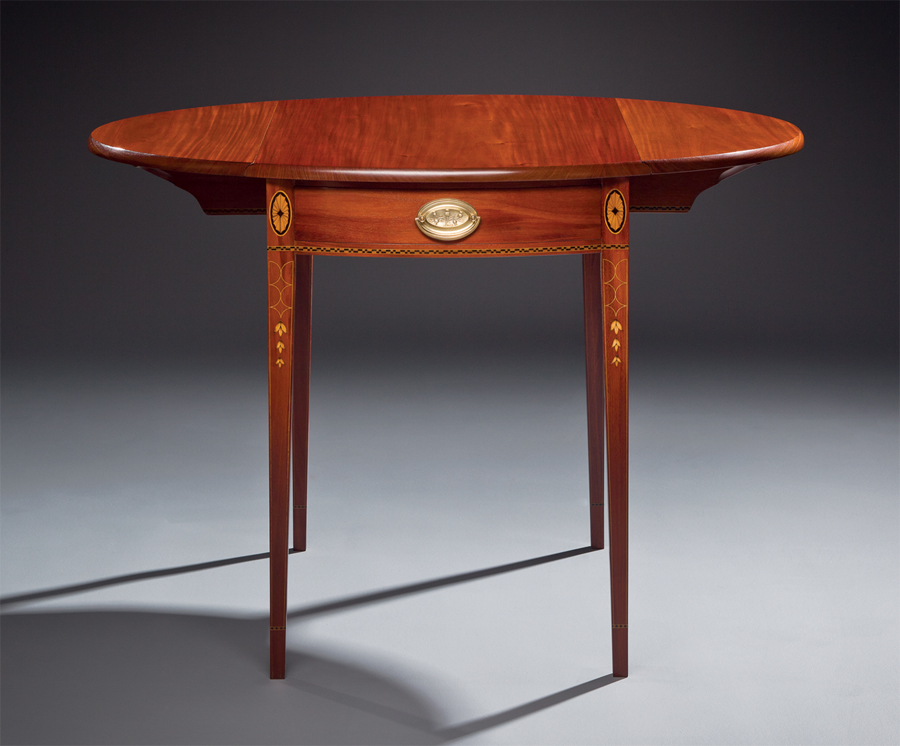MADE IN PRISON
WHEN TERRY MOORE, fine furniture maker in northern New Hampshire, picked up the phone in March 2009, he didn’t expect to hear, “Hi, this is Donny. I’ve been released.” The voice belonged to Donald Briere, and Moore instantly pictured the man in the State Prison for Men in Concord, standing in a blizzard of wood chips, pressing into the wood lathe, creating vases made from thousands of wood pieces.
“Come see me,” said Moore, a soft-spoken guy with a slight lilt of Welsh. He and Tom McLaughlin run the Prison Outreach Program for the New Hampshire Furniture Masters Association (NHFMA) in Concord prison.
Meeting at a local diner, Briere explained he was living with his parents, buying tools off Craigslist, and making wood vases on a small lathe with a bad bearing. It sounded, to Moore, like a tough start—trying to create large, quality vases on a small, defective machine. He encouraged Briere to sign up for the Annual Craftsmen’s Fair, held every August at Mount Sunapee Resort in Newbury, NH, which draws 35,000 people. He thought the nine-day fair would be a good place for him to sell vases.
To qualify, Briere had to be a member of the League of New Hampshire Craftsmen and present his work before a jury. “It was nerve-wracking,” the woodturner recalls, “like waiting for your first child to be born.” The league accepted him. Then the NHFMA helped him purchase a professional lathe, so he could craft high-end wood segmented vases. He created a 32″ vase, made from 1,700 wood pieces: cherry, maple, walnut, padauk, purple heart, osage orange and bubinga, adding bands of turquoise, malachite and pink coral inlays. Then Briere had to go before another jury, to be accepted into the exclusive Living with Craft exhibition area of the Craftsmen’s fair. He got into that too.
The vase sold immediately—for just under $2,000. A commission for a similar vase followed. The biggest surprise came on Friday when it was announced that Briere had won Best in Show, beating out all the other exhibitors, including his mentor Terry Moore.
New Hampshire Chronicle heard about this and sent a film crew. Word circulated at Concord prison, and the night the program aired, for once the inmates agreed on which program to watch. They saw Briere—once one of them—successful and proud. Later someone inside the prison told him, “There wasn’t a dry eye in the place.”
The Prison Outreach Program began back in 2000 when Superior Court Judge Kathleen McGuire asked NHFMA if they’d be willing to start a furniture-
making program in Concord prison’s Hobby Craft Shop. When Moore and Jon Brooks visited, they discovered a large, well-lit space with individual workstations and power tools. Quickly they could see they’d need hand tools, a vacuum press and some other equipment. McGuire encouraged them.
Moore didn’t need much convincing. He had taught in a Vermont prison and saw “how hungry these guys were to get their minds off being in prison. You can give them an alternative, and it’s like turning a light on in a dark room. You can see the transformation as they learn the craft.”
Moore contacted tool and equipment manufacturers for discounts and donations. Two inmates were selected to oversee and mentor others: Tim Eldridge and Eric Grant. Then, they set a goal: two works completed by NHFMA’s annual auction—just months away.
Eldridge’s project was a Shaker table with five drawers. “I just figured we’d do what we normally do, cut the dovetails on the machine,” he says, yet he quickly learned he’d have to cut them by hand. “I kept cutting pieces off and doing it over and over. Finally it comes to you.” In a week, he had it down. Then he had to wrestle with the drawer fronts. He’d chosen birdseye maple, a shimmery gold, but dense hardwood. He says, “We didn’t always have the right tools, so it was all a bit trial and error.”
Still, he persisted. He learned to look for solutions and to not give up. “Woodworking teaches you a lot of patience, and a lot of people in there really need that—I did,” says Eldridge.
“Anything that gives a guy a positive outlook is not only good for the prisoner, but good for society,” he says. “That’s better than having a guy sit around 20 hours a day in his cell thinking of bad things to do.”
In October 2000, NHFMA displayed both Grant and Eldridge’s furniture. McGuire bought Grant’s, and Governor John H. Sununu not only bought Eldridge’s Shaker table, but commissioned him to make a second one, which he placed in the State House.
Increasingly, people like McGuire search for ways to reduce recidivism. A 2014 report from the New Hampshire Department of Corrections shows that 43 percent of the state’s inmates released in 2008 had returned—half within six months. With prisons being so overcrowded, more and more people are asking, what can be done to make ex-offenders’ re-entry into society more successful?
It appears inmates need something more than just a course in small engine repairs. While the Prison Outreach Program teaches fine woodcraft—how to hand-cut dovetails and joints, carve and turn cabriole legs, inlay exotic woods, book-match veneers and hand apply finishes—there’s something more transformative that occurs. There’s a change in the way inmates think.
For instance, Eric Grant was a furniture maker before entering the NHFMA’s program, but he’d never done such fine detailing and handwork, such as string and bellflower inlays. By selling some of his work through Grevior Furniture in Franklin, he earned enough money to finance two college degrees, buy fine woodworking tools, and create a small savings for when he’s finally released.
It’s the transformation in prisoners that compels the furniture masters to invest so much time and personal resources into this program. Brian Reid, who kicked off a new Prison Outreach Program in the Maine State Prison in Warren, says, “These guys come into this program not knowing what it means to be a craftsman. It’s patience and creativity. It’s precision. This is something that they don’t know. They come in being sloppy and within a year they learn.”
He continues, “I think the most important thing I’m teaching them is being creative. This makes them so proud. I make them design their own work. They have to draw it up, make sketches, make a model. The light bulb goes on, and it’s amazing.”
His program was a little harder to set up, having to revamp an inadequate shop with very few tools. Reid, who isn’t fond of fundraising, had to raise money. Now having equipment and working with this crew for two years, Reid thinks they’re just about ready for prime time. Some are selling work at the Gallery at Somes Sound, near Bar Harbor. An exhibition is planned for spring.
“This program refocuses their energy into positive directions. The passion of their work transforms their lives. It keeps them on the straight and narrow,” says Reid. When he told an inmate that his table had been purchased by the New Hampshire Historical Society for $1,800, the inmate’s face grew red, totally overcome with emotion.
“It’s probably the most rewarding thing I’ve ever done,” says Reid, who spends three out of four Sundays working in the prison woodshop.
Because the NH Department of Corrections classifies furniture making as a recreational program, it does not measure its potential impact on recidivism. However, Moore has his own assessment: Not one former participant has returned to prison. “Once they get this passion for this highly disciplined trade,” he says, “they never think about getting back into the prison system.”
Prison officials elsewhere are looking at NHFMA’s program. In fact, Richard Oedel, master furniture maker and chair of NHFMA, says the Massachusetts Department of Corrections recently contacted him and asked him if he would consider starting a program there.
Tim Eldridge was just 20 years old when he was locked up for 22 years. He hadn’t developed job skills or a trade yet. He was a young man with a lot of growing up yet to do. Lucky for him, he landed a job in the prison’s Hobby Craft Shop, and it became something like a home for him.
When released in 2010, Eldridge was placed in downtown Manchester, and he recalls nervously walking the streets looking for a job. When he showed the owner of a cabinet shop the pictures of the furniture he’d created in prison, he was hired. He defied the stiff odds of parolee unemployment, which is over 70 percent. Five years later, Eldridge is working in two cabinet shops, making what he describes as a good living for his family.
“I didn’t know it would become such a passion,” says Eldridge about woodworking. “I received such praises. I gained such a sense of accomplishment and pride.”
Now he hopes to buy a house in the spring and set up his own woodshop. Looking back, he credits Moore and the furniture masters for giving him this chance and creating what he calls a turning point in his life.
Debbie Hagan is editor-in-chief for Art New England.

